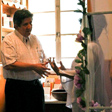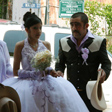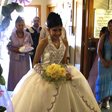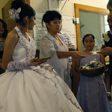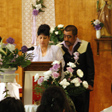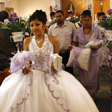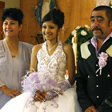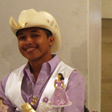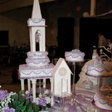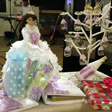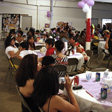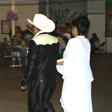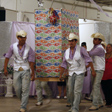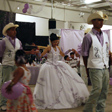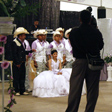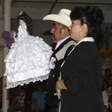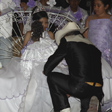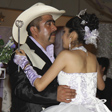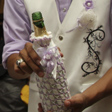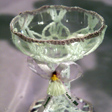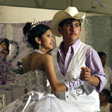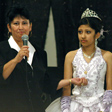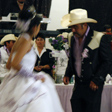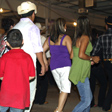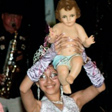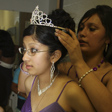Ritual Traditions of Maria Lopez: From Mexico to Louisiana

Making a Quinceañera for Her Daughter
A comparison of Lopez's traditions with Mexican-American traditions discussed in works edited by Cantu and RamÃrez (2001) and Graham (1991) reveals both continuity in her traditions and her own personal innovation and energy. Nowhere is that creativity more evident than in the 2010 quinceañera for her older daughter, Juanita. According to Norma Cantú, the quinceañera, a special 15th birthday celebration, provides the opportunity for Mexican Americans to "perform their cultural identity outside the realm of mainstream U. S. culture (Cantú and Ramirez 16). Cantú, who has discussed the quinceañera as a "liminal event," based on Arnold Van Gennep's model, notes that the sacred and secular event is a "marker of ethnicity and functions as a coming of age ritual that offers the young woman a space to contest and shape the expectations that the symbolic act implies" (Cantú and Ramirez 18). Having a large quinceañera is not a mandatory tradition for girls turning 15. While some quinceañeras were held in Lopez's native village, some families including hers "would just do like a little dinner, just with family" (29 August 2010). Large quinceañeras such as those of her cousins were considered more extravagant. In their new home in Bernice, quinceañeras are considered special and not the rule. Maria Lopez and her husband talked about whether or not to give Juanita a quinceañera. Lopez recalls they had said, if she had "earned the quinceañera," they "would make it." According to Lopez, she and her husband determined that she had been "a good child, obedient, and would do anything and everything" for them. So they decided to "make her a quinceañera" (29 August 2010). They also felt fortunate to have Juanita since she had health problems as an infant that endangered her life. Juanita reports, "They asked me if I would like a quinceañera; I said, 'Sure.' There was money also. Without money you can't do nothing" (29 August 2010). An area priest's remark to me echoed this when he noted that the Hispanic community sees the quinceañera as an important status marker and more of a sign of economic achievement. Cantú notes that before the 1950s, this celebration was more likely to be held for "daughters of the elite," but this changed by the 1960s (Cantú and Ramiriz 17). Nevertheless, in Bernice, and in the Lopez's native village, the special celebration is both an honor and a privilege, and not necessarily the norm. This life cycle ritual is a marker of a change of status from child to adult (see Cantú for a discussion of origins and quinceañera traditions).
Because her knowledge of this coming-of-age tradition is based in her native country, for Maria Lopez the celebration also marks a new set of expectations for her relationship with her daughter following the party: "It's trust, more trust in each other and a little bit more strict also . . . [The mother] can be a mother and at the same time, . . . can be a friend . . . to tell everything, and just talk [to] and get everything straight" (29 August 2010). Even with this newfound friendship, Lopez still has strict rules for her daughter which she reiterates after the event: "We did this party for you. I don't want you to run away; I don't want you to get married that young like the other girls; I want you to live your life" (29 August 2010). Juanita explains further:
My mom is saying when I get married, she wants whoever I'm getting married with to come and talk to my parents because many of the girls here just leave the house and run away with the guys, and so that is what my mom doesn't want me to be. . . . At the same time, you can be a friend, and friendly and everything, but at the same time strict, telling them not to do that stuff. You have to do it the right way. If you want to get married, tell the guy to come here and talk to the parents and get everything straight, and then you can just get married. (29 August 2010)
Although Juanita will have additional responsibilities at home after her quinceañera, for the meantime, she will still have a 10 p.m. curfew and cannot date yet. Thus, the mother, who married at 21, hopes that the quinceañera will encourage her daughter to uphold their traditional beliefs and to fulfill her dreams of maintaining their status in their new country. Based on their Catholic worldview, these beliefs, no doubt, stem from her extensive lay knowledge about their religion and its rituals. A close examination of her daughter's quinceañera shows how Maria Lopez applies her knowledge to produce it, combining religious belief, traditional elements, popular cultural trends, and her own personal improvisations.
Preparations
While neither Maria Lopez nor her three sisters had a large quinceañera, Lopez drew on her knowledge of other family and community quinceañeras to produce her daughter's special event. The resulting event resembled an elaborate wedding involving months of planning, purchasing and making decorations with coordinated colors, and obtaining help from family and friends.
Juanita selected her colors-lavender and white-which were reflected in the both the purchased and handmade decorations, her purchased dress, and the invitation. Many of the commercial decorations were bought in Mexico and Dallas. Among these were the tiara, scepter, bouquet, hair ornament, various figurines, party favors, and the backdrop for the honoree's seat of honor at the party. The event was formally announced with a special lavender and white invitation that was printed in Mexico. To assemble the invitation, Lopez folded it into a box-shape, topped it with a lid featuring a photo of Juanita, and tied it with a lavender ribbon. The invitation announced the mass to be held at noon at the Our Lady of Perpetual Help Catholic Church in Farmerville, and the following party at the Bernice Civic Center.
In the months leading up to the event, the family was busy with preparations for the dress, decorations, and other plans for entertainment and documenting the quinceañera. On a trip to Dallas with the help of relatives of Juanita's godparents, they found Juanita's white evening gown with lavender trim, matching decorations, a norteña band, and a photographer. Lopez, with help from her relatives, made many of the decorations to match the lavender and white color scheme. Drawing on her knowledge of crochet learned at age eight from her mother, Lopez worked without patterns to design crocheted covers for the champagne bottles and glasses, the salt and pepper shakers, and the tortilla and salsa containers that would be used to both serve and decorate the party tables. She also crocheted lace on the cloths that would keep the tortillas warm. Her mother, who came to visit before the quinceañera, helped with some of the crochet. Some of these crocheted items would function as favors for special guests.
Decorations
Typically, the quinceañera honoree chooses her court of 14 young men (chamberlains, termed chambelanes in Spanish) and young women (damas). However, the Lopez court was different. Juanita explains how she decided on her court: "Traditionally they have 14 damas and 14 chambelanes, but I couldn't find all of them, so I decided to have eight chambelanes." One of these was her older brother, and the others were "close friends" (29 August 2010).
In the weeks just before the event, Juanita and her eight chambelanes practiced their dance. The dance would be her first time to dance with young men. Maria commented on the significance of the dance at the party: "One rule supposedly in the tradition, if you want a quinceañera, you can't have [a] boyfriend before you're 15, and you can't dance" (29 August 2010). Juanita elaborates on this: "You can start dancing at your quinceañera party. That's when you start dancing with your friends. At other parties, I used to dance with my family only, only family; no dancing with guys. That's a tradition of the quinceañera" (29 August 2010). Juanita and her mother also improvised on the chambelanes' outfits for the event, as Juanita recounts:
I always wanted to dress them up as the Musical Scorpions [Alacranes Musical, a Mexican-American band]. That was my choice. [The band] was different from how I dressed them up because they were going to wear this suit-tux-they were only going to wear the tux [jacket] with some jeans, but then I went with this chambelane to measure him to see if it fit him, and he was like, "Don't you think it's going to be too hot for us all to be wearing this hot stuff?" So he said, "Why don't we just wear the vest? It will look better, and you know, it's what they are using now; everybody is using the tux, the vest."
So I'm like, "Ok, yeah, so I'll just ask all the chambelanes if y'all would just like the vest," and so, they are like, "Yeah, it's better; we all can wear it and not take it off, 'cause like, if we have the tux, we're going to have it off and on because of the hotness." And they wasn't going to wear ripped jeans, but then they all said, "Why don't we just wear ripped jeans?"
And my mom said, "How are you going to wear ripped jeans? They're [people attending] going to say, 'Y'all got them from the trash can." [laughter] . . . and so then we all go into the mall to get them some ripped jeans. (29 August 2010).
Since the chambelanes shirts were somewhat large for them to wear under the vests, Maria altered the shirts to fit each one by taking up the sleeves and sides of the shirts on her sewing machine.
Her attention to such details as the clothing, decorations, and even the food for the party made sure the event would be attractive and run smoothly. The smallest details were taken care of before the event. On the day before the event, Mr. and Mrs. Lopez prepared all the food for the party. Mr. Lopez stayed up all night supervising four fires roasting one steer and three pigs.
The Mass
Looking back on the whole quinceañera, Maria Lopez found the mass to be her favorite part. On the day of the quinceañera, as the guests were arriving, Maria Lopez also arrived early to talk with the priests about the last-minute details. Intent on following the traditional mass she had learned in Mexico, she wanted her daughter to sit in a chair at the head of the aisle in front of the altar after the processional including her family, god parents, and chambelanes. However, the relatively new church priest wanted her to sit in the front pew. On hearing this, Mrs. Lopez appealed to the visiting officiating priest who was more experienced in the Mexican ritual for permission to seat her daughter as she wished, and he agreed. Thus her lay knowledge of the ritual took precedence over standard American Catholic practice.
The church had been decorated with lavender and white the day before by Maria and her family. The main decorative flowers in the church, which would be taken afterwards to the party, were artificial, but handmade.7 The lavender and white flowers chosen to match the color scheme selected by Juanita were indeed special, for they were made by her aunt in Mexico with a mold that shapes the petals, which are then gathered together and bound to a stem. These floral bouquets were placed along the aisle and beside the altar in eight wrought-iron stands. Lopez's brother-in-law in Mexico had made the stands and sent them for the party. After the mass, these bouquet stands would be moved to the party. Over the central aisle was an arch covered with tulle and lavender and white flowers. Behind the altar were four lace drapes with floral bouquets. The altar was covered with a white cloth and set with two candles which were lighted by the priest. A small prayer table covered with a white cloth and roses sat in front of the altar with the chair in front of it for the honoree, Juanita.
With this setting, the mass began at noon. Juanita arrived in a white SUV and was escorted into the church vestibule by her parents, where they lined up for the procession. The procession included the chambelanes, the honoree, her godparents, and her parents. Juanita carried fresh white roses to be presented later in the mass to the Virgin Mary. She stopped at the altar at her designated chair, while the rest of her party took seats in the front pews.
The mass included religious elements traditional to the ceremony. The officiating priest opened the special mass in Spanish explaining the purpose of the event, welcoming the guests, and talking about the Lopez family's contributions to the Spanish ministry in the church. He continued with comments about the honoree and provided religious instructions for her life. Her brother then presented a scriptural reading from the Book of Ruth. Hymns in Spanish were performed by a small choir accompanied by a guitar. During their performance, a recessional by the honoree and her court preceded an offering for the church taken by the chambelanes. Then the court came back to the altar for Holy Communion which was blessed by the priests and served by Juanita's father, Alfredo Lopez. Following the communion, Maria Lopez made a statement of gratitude for her daughter's life. As she recalled later, this was the most important part of the mass for her because it allowed her to give "thanks to God for having her [Juanita] until she was 15 years old because when she was small in my belly, they said that she was dead; she wasn't going to live. . . I am happy to have her up to 15" (Lopez 29 August 2010).
Juanita then responded to her parents, thanking them and making a testimonial of how she would live her life according to her religious teachings. Then accompanied by her godparents, she made her offering of white roses to the Virgin Mary altar at the left of the church. Following were presentations of symbolic gifts, including a Bible from her parents, a rosary from her brother, jewelry from her godparents and relatives: earrings, necklace with a Virgin of Guadalupe medal, and a watch with the Virgin's image. After receiving prayers from her friend, the priest gave the final blessing which was followed by the recessional. The honoree, family, and court then gathered back inside the church for photographs while the guests went on to the party in Bernice.
The Fiesta (Reception Party)
The reception following the mass featured many decorations and layout typical of area quinceañeras and lasted from mid-afternoon until early the next morning. Guests arriving at the party around 2:30 p.m. found similar lavender and white balloon and floral decorations. Centered near the main stage sat the honoree's "throne" festooned with a balloon-covered arch with a Disney-like Quinceañera character dressed in a lavender and white dress with the words "Mis 15 Años" (my 15 years) on the skirt. In front of the throne was a table with coordinated figurines, heart-shaped frames, and champagne bottles for the honoree and her special guests. On each side of the throne table were long tables for the chambelanes decorated with figurines, a champagne bottle in a holder, the scepter, and a pillow with a tiara carried from the mass by the godmother. Opposite the throne were two other tables-one holding a doll, a tree with champagne glasses, and a scrapbook and guestbook, and the other holding the five coordinated cakes on stands of varying heights made by a relative of Mr. Lopez; the central tiered cake was topped with a church spire with bells. Gifts for the honoree were scattered on the various tables. Providing seating for over three hundred guests, over thirty large tables with chairs flanked the concrete dance floor. Each table was decorated with a wrought-iron stand with the roses handmade by Juanita's aunt and uncle. The walls opposite the stage were lined with chairs for other guests.
The quinceañera and her court waited to enter the party after many of the guests had arrived just as they had at the mass. In this procession the young flower girl preceded the honoree, followed by her parents, god parents, sister, and chambelanes, who escorted her to the place of honor. The chambelanes took their seats at their tables next to Juanita's table, and the parents scurried about with hosting duties, supervising the food and drink, and visiting with guests.
Soon after guests were settled, an area band, Envision, began to play norteña music in an alcove next to the main stage. Later in the evening, the featured band, Impresso, from Dallas played on the main stage. Then later the two bands would alternate to give each other a break since the party lasted until the early morning hours. Although children ran and played on the dance floor, guests did not begin dancing until later, after all of the symbolic ritual acts were held and Juanita had danced with various partners. In mid-afternoon, food serving began buffet style and would continue through the evening. The menu included barbecue beef and pork, refried beans, fried rice, salsa, tortilla, and cold drinks. The cake would be served after 10:30 that night. During the afternoon and into the evening guests ate, visited, and took snapshots of each other and the quinceañera (the honoree) and her court.
Just after 6 p.m. the special program and symbolic acts of the secular ritual began. The room lights were dimmed so that a video production, entitled "Mis XV Años: Juanita" made by the photographer could be presented on the screen on stage. With sentimental background music, the video featured photos of Juanita at different ages and her prayer of thanks for her life and her parents. The video focused all attention on the honoree, making it clear that she was the reason for the occasion. After the video, the lights came back up, and Juanita had left the room.
Guests waited until after 7, when the chambelanes entered from a side door carrying what appeared to be "the big gift" over six feet tall on a large wooden platform with handles on each end. Except for its gigantic size, such a gift did not seem so unusual since many of the quinceañeras and presentations in the area include the tradition of "the big gift," a large gift-wrapped box filled with various smaller gifts to be opened by the honoree. For Juanita's quinceañera, after the chambelanes placed the box carefully it on the dance floor, a recording of the "Triumphal March" from Verdi's Aida began. When the chambelanes pulled down the panels of the box, instead of the traditional small wrapped packages, Juanita herself emerged in a cloud of lavender and white balloons. According to Juanita, this was her mother's idea. Lopez's playful, creative and thankful spirit plays with her knowledge of the traditional big gift, transforming it to symbolize the great gift of her precious daughter that she is now sharing with the community.
While children scampered to grab the balloons, Juanita and her chambelanes swayed from side to side, as an announcer introduced each of the chambelanes, who marched onto the dance floor, and formed two lines as their names were called. (The family happily told me later that this was on YouTube.) The march music faded into a recording of "Fascination," signaling the beginning of the special dances they had practiced. Juanita gracefully twirled down between the two lines formed by her chambelanes, and then began her first dance, a waltz, with one of her chambelanes. Then the group marched off the dance floor. Although her large bouffant skirt presented a challenge, Juanita managed it beautifully in spite of her admitted nervousness: "I was nervous. You know, they all have their attention on me, 'Oh, what if I do something wrong?' Like with the dance, the special dance we did with all my chambelanes; I'm like, you don't have to mess up because everybody is watching you; yes, I was kind of nervous" (29 August 2010).
Evening Presentations and Dancing
Juanita and her chambelanes then gathered in front of the stage for three traditional symbolic presentations. The presentation of her crown (tiara or diadem) and scepter, the last doll, and the high heel slippers signify the end of childhood and the beginning of her adult life, which will permit dancing and courtship. Her godfather and godmother put the crown on her and gave her the scepter which indicated her new power as a woman and princess for the evening. Juanita explains why the crown was given at the party: "They were supposed to do it at the church, but they said it would be a long mass" (29 August 2010). More official photographs with her parents and others were made after she had received her crown. Then her mother and father walked across the dance floor to present the doll. Juanita explains the meaning of the doll: "My daddy and my mom picked it, to be mostly a surprise. She's saying the doll means I'm growing up, it is not for me to be playing with dolls; now, I'm leaving the dolls behind. That's why they picked it out." Then her father kneeled to remove her low-heeled sandals in exchange for her silver high heels. Then she danced the first dance with her father. Juanita noted that she had danced only one dance in her heels after she received them; she preferred her low-heeled sandals for her many dances that came later.
The serving of champagne by the chambelanes and toasting followed. The champagne bottles were encased in Maria Lopez's own lavender and white crochet as were some of the plastic champagne glasses set on each table. This elaborate crocheted decoration symbolized that the beverage was truly special. In fact, it was the only alcoholic beverage served. While drinking alcohol is not common in this family, the toast was a symbolic act allowing Juanita to consume an "adult" drink to signify her change in status from child to woman. While some guests chose to toast with soft drinks, everyone participated in the toast to the guests and Juanita. No other alcohol was served; some went outside to drink, as is customary at some other north Louisiana events in other cultural groups as well.
More celebratory dancing traditions followed. After the toast, Juanita danced briefly with a sequence of partners, beginning with her father, then her brother, and others who chose to cut in on the prior partner. When the band took a break, her parents made a formal speech to their daughter and their guests, thanking them for coming and sharing the occasion. Juanita danced one more special dance with her father-a huapango (a traditional norteña fast dance style). After this dance, the guests could now begin dancing. The dancing was briefly stopped when a young man arrived to present a gift of a Baby Jesus statue-the only one of the guests' gifts to be opened that evening. Mrs. Lopez explained that he was the fiancé of a dear family friend who had died in an accident that year, and he gave it in memory of her, so it was indeed a special gift. Dancing resumed and would last until the early morning, interrupted briefly by the cutting of the cake. Juanita cut her own piece, and her aunt served the cake. They did not save any to freeze as is the custom in weddings. The remainder was brought home and eaten the next day by visiting family. During the next few hours, Juanita would change into a more comfortable lavender dress for dancing and back into her gown for more photos. Even later, she changed to jeans. Maria Lopez had changed to a black dress with white trim early in the reception so she would be more comfortable and would be dressed more appropriately for the cleanup later which would last until 4 a.m.
Epilogue
Looking back on the event, the family pronounced it successful. Juanita summed it up: "I felt very, very happy because my parents did this big party for me, and you know, it was very beautiful to have a quinceañera; I felt very special" (29 August 2010). Maria Lopez pronounced it "beautiful" and was happy that the whole family came. She also liked that so many of the decorations were "all handmade," and Juanita liked that "the family got together to help make my quinceañera" (29 Aug. 2010). Lopez saw this particular quinceañera as "different because it was for my own daughter," so she put "more love" into it. Whereas for other parties, people told her what kind of decorations they wanted, for Juanita's celebration, Lopez says she could "invent it in my head, trying to make everything else different from others" (Lopez 29 August 2010). The crocheted covers for the serving pieces at the party, Juanita's surprise entry in the big gift box, the choreographed dances, the special cake and handmade floral decorations-all of these made the event special and unique and reflected not only Maria Lopez's love for her daughter, but also her aesthetics and her deep knowledge of tradition. Her eye for color, attention to detail, and ability to innovate within the tradition are apparent in the whole event. Giving a quinceañera for the daughter who had managed to live in spite of the experts' predictions allows Mrs. Lopez to use her knowledge to express her gratitude elaborately in the mass and the reception through her verbal thanks, her decorations, and orchestrations of the ritual.
Recognizing her mother's knowledge of tradition, Juanita gives her credit: "My mom was the one with the whole big idea. She was pretty much the idea behind everything" (Lopez 29 August 2010). She uses her knowledge from her native land both to teach her children about their Mexican heritage and to enhance their status in their Mexican-American community. She not only knows these traditions, but also performs and improvises on them in sharing and transmitting them in her new country. Empowered by her deep knowledge of her traditional Mexican heritage and her creativity, Lopez celebrates and shares the gift of her daughter and that heritage through her gift of the quinceañera for her daughter, family, and community.


